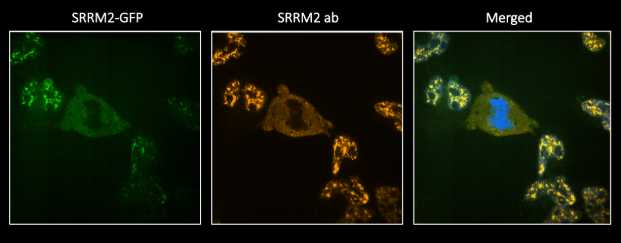Nuclear Speckle Protein SRRM2 Dissolves During Anaphase in Ewing Sarcoma Cells
Posted in News Story
A new study led by Dr. Jeffrey Toretsky and his team at Georgetown University investigates the role of the nuclear speckle protein SRRM2 in Ewing Sarcoma (ES), offering fresh insights into how oncogenic condensates influence gene regulation. The research, conducted in collaboration with Julie Forman-Kay’s lab at the Hospital for Sick Children in Toronto, uses advanced imaging techniques to track SRRM2 dynamics in live and fixed ES cells.
Scientists have long understood that membrane-less nuclear bodies, like nucleoli, dissolve during mitosis. This study provides direct evidence that SRRM2, a key splicing factor, undergoes a similar process during anaphase in ES cells. By employing CRISPR-Cas9 technology to tag SRRM2 with moxGFP, the team developed a validated system to study splicing regulation in live cells.

Visualizing SRRM2 During Cell Division
This study used fluorescence microscopy to capture SRRM2 condensates as they dissolve during mitosis. The image, taken on a Nikon SoRa spinning disk microscope, shows:
- SRRM2 tagged with moxGFP (green) and antibody-labeled SRRM2 (orange).
- DAPI-stained chromatin (blue), highlighting mitotic progression.
- Merged visualization of nuclear speckle disassembly at anaphase.
Validating this fluorescent system was essential for tracking SRRM2 and mRNA interactions in real-time. The team faced challenges in optimizing the moxGFP signal in fixed cells due to fluorescence quenching, highlighting the need for live-cell imaging in future studies.
Why It Matters
Understanding the molecular mechanisms of Ewing Sarcoma is critical for advancing cancer research. SRRM2 is a major splicing scaffold, and its interactions with EWS::FLI1, the oncogenic driver of ES, may play a role in cancer progression. Insights from this study could inform targeted therapies that disrupt oncogenic condensates, potentially leading to new treatments for rare and aggressive cancers.
About the Researchers
Dr. Jeffrey Toretsky leads this research at Georgetown University.
Olivia Oakley performed immunostaining and microscopy.
David Allegakoen developed the CRISPR knock-in model.
Emma McGuire is conducting live-cell SRRM2 imaging experiments.
This research will be presented at the Children’s Cancer Foundation symposium in June, marking an important step in understanding nuclear speckle dynamics in cancer biology.
